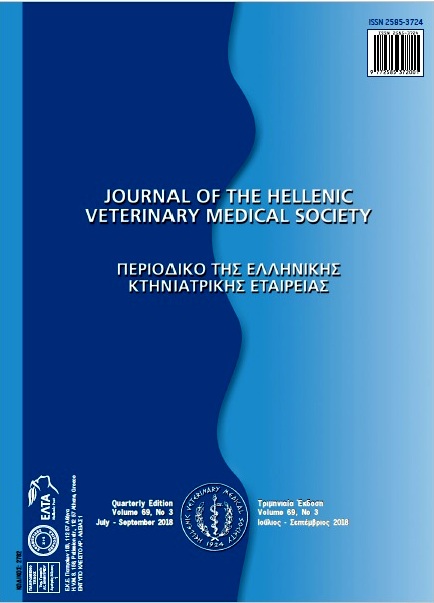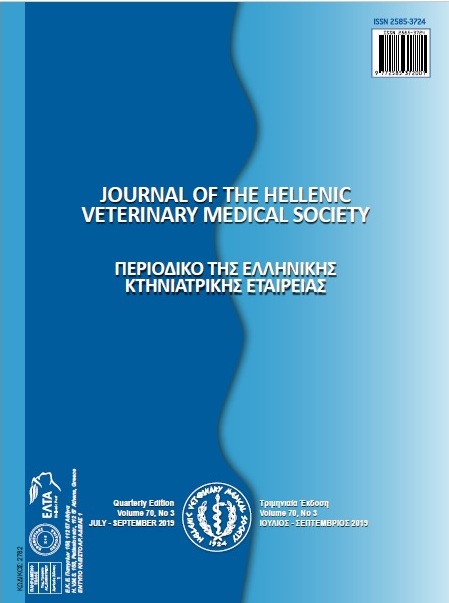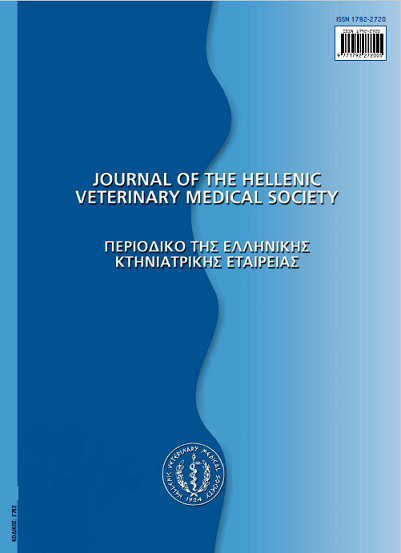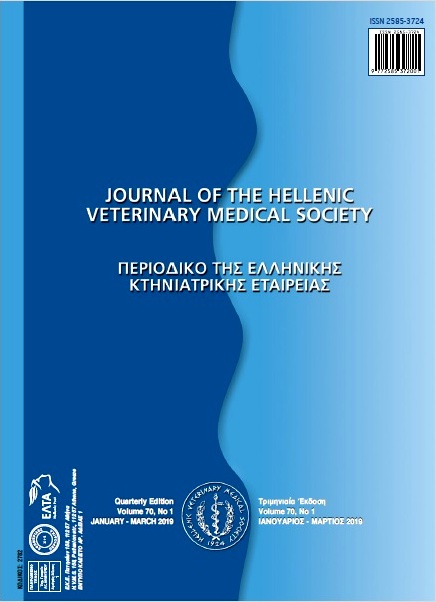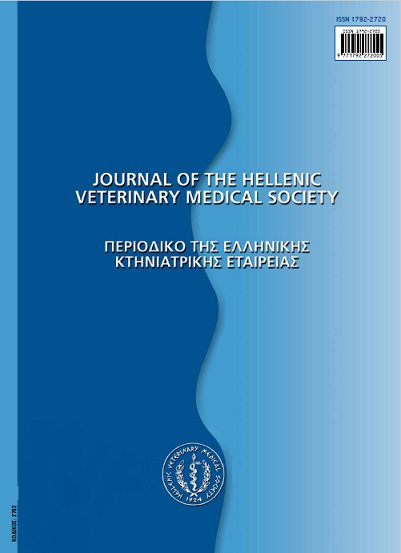Μοριακή διερεύνηση και γεωγραφική κατανομή της μόλυνσης από Leishmania spp σε δεσποζόμενες και αδέσποτες γάτες (Felis catus) στη Θεσσαλία
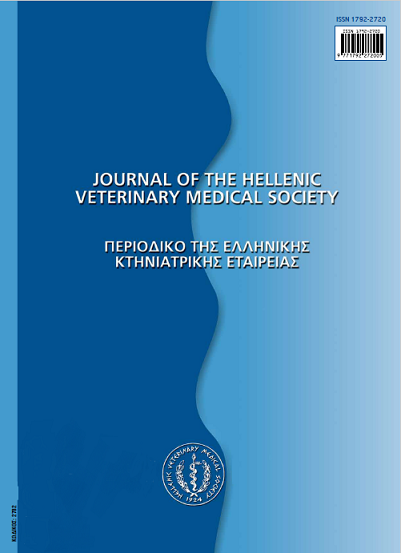
Περίληψη
Σκοπός αυτής της μελέτης ήταν ο προσδιορισμός του επιπολασμού της μόλυνσης και η αναφορά της γεωγραφικής κατανομής των μολυσμένων γατών από πρωτόζωα του γένους Leishmania spp στη Θεσσαλία, μια περιοχή ενδημική για τη λεϊσμανίωση του σκύλου και των ανθρώπων. Δείγματα αίματος συλλέχθηκαν από 150 γάτες (34 αδέσποτες και 115 δεσποζόμενες) από τις Περιφέρειες Λάρισας (ν=6) , Βόλου (ν=94), Τρικάλων (ν=30) και Καρδίτσας (ν=20). Για κάθε γάτα που συμπεριλήφθηκε στη μελέτη, συλλέχθηκαν δημογραφικά δεδομένα και στοιχεία σχετικά με τις συνθήκες διαβίωσης. Τα δείγματα εξετάστηκαν με τη μέθοδο της ένθετης αλυσιδωτής αντίδρασης πολυμεράσης για την ενίσχυση της περιοχής Internal Transcribed Spacer 1 (ITS1 nested PCR) του γονιδιωμάτος του πρωτόζωου Leishmania spp. Τα γεωγραφικά συστήματα πληροφοριών (GIS) χρησιμοποιήθηκαν για τον προσδιορισμό της γεωγραφικής κατανομής των μολυσμένων γατών ως προς τις χρήσεις γης και το υψόμετρο. Συνολικά, το 13.3% (95% CI: 8.3-19.8) των γατών που εξετάστηκαν βρέθηκε θετικό στην παρουσία του DNA του πρωτόζωου Leishmania spp. Ειδικότερα, ο επιπολασμός των PCR θετικών γατών βρέθηκε να είναι 12.8% (95% CI 6.8-21.2) στην Περιφέρεια Βόλου, 20% (95% CI 7.7-38.6) στην Περιφέρεια Τρικάλων και 10% (95% CI 12-31.7) στην Περιφέρεια Καρδίτσας ενώ καμία από τις έξι γάτες που εξετάστηκαν από την Περιφέρεια Λάρισας δεν βρέθηκε PCR θετική. Οι γάτες που βρέθηκαν θετικές στην παρουσία του DNA του πρωτόζωου Leishmania spp ζούσαν σε αστικές περιοχές και σε καλλιεργούμενες και διαχειριζόμενες εκτάσεις με μέσο υψόμετρο 81,7 μέτρα (εύρος 14 - 225 ± 51.57 SD) από το επίπεδο της θάλασσας. Από τη στατιστική ανάλυση δεν προέκυψε καμία σημαντική συσχέτιση μεταξύ της μόλυνσης από Leishmania spp και των δημογραφικών δεδομένων ή των συνθηκών διαβίωσης των γατών καταδεικνύοντας ότι η μόλυνση είναι ομοιόμορφα κατανεμημένη στον πληθυσμό των γατών που ελέγχθηκε. Τα ευρήματα αυτής της μελέτης σε συνδυασμό με την παρουσία κατάλληλων διαβιβαστών του πρωτόζωου Leishmania infantum στη Θεσσαλία, ενισχύουν την υπόθεση ότι οι γάτες μπορεί να λειτουργούν σαν δεξαμενή των πρωτόζωων Leishmania spp στην περιοχή και υπογραμμίζει την ανάγκη για επιτήρηση του πληθυσμού των γατών καθώς και για εφαρμογή προληπτικών μέτρων. Παρ’όλα αυτά, ο ρόλος της γάτας στη διατήρηση και τη μετάδοση των πρωτόζωων Leishmania spp δεν έχει ακόμα καθοριστεί και αξίζει περεταίρω διερεύνηση.
Λεπτομέρειες άρθρου
- Πώς να δημιουργήσετε Αναφορές
-
GIANNAKOPOULOS, A., TSOKANA, C. N., PAPADOPOULOS, E., SPYROU, V., CHATZOPOULOS, D. C., VALIAKOS, G., TOULOUDI, A., ATHANASIOU, L. V., & BILLINIS, C. (2018). Μοριακή διερεύνηση και γεωγραφική κατανομή της μόλυνσης από Leishmania spp σε δεσποζόμενες και αδέσποτες γάτες (Felis catus) στη Θεσσαλία. Περιοδικό της Ελληνικής Κτηνιατρικής Εταιρείας, 68(1), 27–34. https://doi.org/10.12681/jhvms.15553
- Τεύχος
- Τόμ. 68 Αρ. 1 (2017)
- Ενότητα
- Research Articles

Αυτή η εργασία είναι αδειοδοτημένη υπό το CC Αναφορά Δημιουργού – Μη Εμπορική Χρήση 4.0.
Οι συγγραφείς των άρθρων που δημοσιεύονται στο περιοδικό διατηρούν τα δικαιώματα πνευματικής ιδιοκτησίας επί των άρθρων τους, δίνοντας στο περιοδικό το δικαίωμα της πρώτης δημοσίευσης.
Άρθρα που δημοσιεύονται στο περιοδικό διατίθενται με άδεια Creative Commons 4.0 Non Commercial και σύμφωνα με την άδεια μπορούν να χρησιμοποιούνται ελεύθερα, με αναφορά στο/στη συγγραφέα και στην πρώτη δημοσίευση για μη κερδοσκοπικούς σκοπούς.
Οι συγγραφείς μπορούν να καταθέσουν το άρθρο σε ιδρυματικό ή άλλο αποθετήριο ή/και να το δημοσιεύσουν σε άλλη έκδοση, με υποχρεωτική την αναφορά πρώτης δημοσίευσης στο J Hellenic Vet Med Soc
Οι συγγραφείς ενθαρρύνονται να καταθέσουν σε αποθετήριο ή να δημοσιεύσουν την εργασία τους στο διαδίκτυο πριν ή κατά τη διαδικασία υποβολής και αξιολόγησής της.



